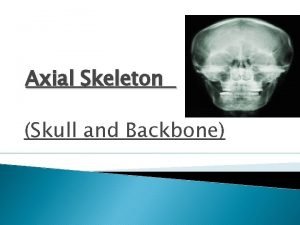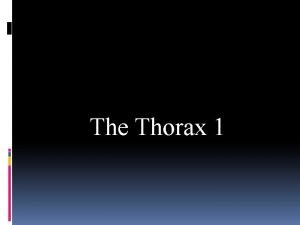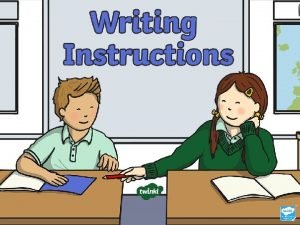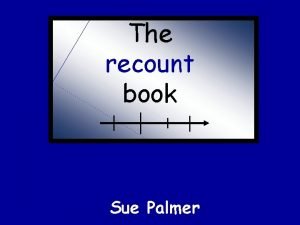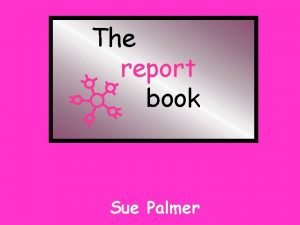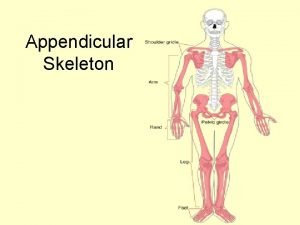Instructional writing Text skeleton for instructional writing Why













- Slides: 13

Instructional writing

Text skeleton for instructional writing Why?

What are the key features of instructions? • What makes effective or good instructions? Think about: • What features of language worked in the starter? • What caused problems?

How to juggle • Juggling is a matter of learning to catch and throw at the same time. Work up from one ball to two balls to three balls.

Instructions on how to juggle • Things You'll Need: • 3 Bean Bags • 3 Juggling Balls

Instructions • • • • Step 1 Hold a ball in your right hand. Step 2 Be aware that as you juggle, you'll be moving your hands in two independent circles - your right hand clockwise and your left hand counter-clockwise. The left hand lags about half a rotation. Step 3 Throw the ball with your right hand so that the apex - the highest point of its path is about head-high. Step 4 Catch the ball as it drops into your left hand, then throw it up again, catching it with your right hand. Practice this maneuver. Step 5 Proceed with a ball in each hand continue as you did with one ball, throwing the second ball just as the first reaches its apex, and catching each ball with the other hand. Step 6 Practice with two balls until you feel confident. Try starting with the left hand once you've mastered starting with the right. Step 7 Add a third ball by starting with two balls in your right hand one ball in your left hand.

What are the key features of instructions? • Title indicates how to…… • materials/ list of equipment needed • clear sequence indicated by bullet points/ numbers/ letters • written in chronological order • contains step-bystep diagrams/ pictures • present tense • imperative verbs (e. g. trace, cut, put • plain vocabulary clear short sentences • connectives relate to chronology • Use of the word ‘you’ to talk directly to the reader • short sentences • active voice • passive voice used occasionally (e. g. when glue is applied

CAKE . Self-raising flour caster sugar baking powder jar of mayonnaise Cocoa boiling water vanilla essence instant coffee Cocoa hot water soft margarine icing sugar It is very important that you make sure you have mayonnaise for this recipe and not salad cream! It will take a bit of time to get all the mayonnaise out of the jar, but try to get it all out. Get some self-raising flour into a bowl and add the caster sugar and baking powder. You are ready to add the mayonnaise when you have stirred it all up. you should now beat the mayonnaise well into the flour, sugar and baking powder use a fork or a whisk

Mayonnaise chocolate cake Ingredients: 275 grams selfraising flour 225 grams caster sugar 1½ teaspoons baking powder 200 gram jar of mayonnaise 4 tablespoons cocoa 225 mls boiling water 1 teaspoon vanilla essence • Method: It is very important that you make sure you have mayonnaise for this recipe and not salad cream! It will take a bit of time to get all the mayonnaise out of the jar, but try to get it all out. • Sift the self-raising flour into a large mixing bowl and add the caster sugar and baking powder. • Give a quick stir together and you're ready to add the mayonnaise. • Beat the mayonnaise well into the flour, sugar and baking powder. It is very important to beat the mayonnaise thoroughly into the dry ingredients.

When planning your writing think PALL! • Purpose • Audience • Language • Layout

What are the key features of instructions? REMEMBER! • diagrams • illustrations • numbers • bullet points • Keep everything in order

Plenary • What are the key features of instructional text? • Draw the text skeleton for instructions • Write three top tips for writing good instructions

Plenary How will you remember the key features of instructions: • Next week? • In a months time? • In 1 years time?
 Appendicular vs axial skeleton
Appendicular vs axial skeleton Appendicular vs axial skeleton
Appendicular vs axial skeleton Axial skeleton vs appendicular skeleton
Axial skeleton vs appendicular skeleton Text to text text to self text to world
Text to text text to self text to world Andreas carlsson bye bye bye
Andreas carlsson bye bye bye Kyssande vind
Kyssande vind Dont ask why why why
Dont ask why why why Who needs instructions
Who needs instructions Sue palmer explanation text
Sue palmer explanation text Sue palmer writing frames
Sue palmer writing frames What is micro teaching definition
What is micro teaching definition Formuö
Formuö Typiska drag för en novell
Typiska drag för en novell Nationell inriktning för artificiell intelligens
Nationell inriktning för artificiell intelligens

